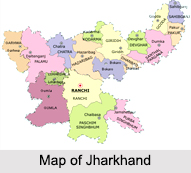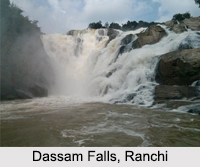 Jharkhand is an eastern Indian state that is bordered by Bihar, West Bengal, Odisha and Chhattisgarh. Jharkhand with its capital city, Ranchi has a tribal culture and history along with natural beauties. Jharkhand is also popularly known as Vananchal (vana plus anchal, meaning land of woods).
Jharkhand is an eastern Indian state that is bordered by Bihar, West Bengal, Odisha and Chhattisgarh. Jharkhand with its capital city, Ranchi has a tribal culture and history along with natural beauties. Jharkhand is also popularly known as Vananchal (vana plus anchal, meaning land of woods).
History of Jharkhand
Jharkhand is known for its forests and the tribal kingdoms. During early era of Sixteen Mahajanpadas around 500 BC, India saw the emergence of 16 large states that controlled the entire Indian subcontinent. Later it came under the hands of the Mughals. After Independence, the Jharkhand Party grew politically stronger but the commissions later examining the demands for a separate Jharkhand State rejected it one after another. There Jharkhand emerged on November 15, 2000 as a new state in India.
Geography of Jharkhand
Jharkhand occupies 28833 sq meters and its capital is Ranchi. It was carved out of the southern part of Bihar state on November 15, 2000. Jharkhand shares its border with the states of Bihar to the north, Uttar Pradesh and Chhattisgarh to the west, Odisha to the south, and West Bengal to the east. Some of the major cities of Jharkhand are Jamshedpur, Bokaro Steel City, Sindri, Deoghar, Hazaribagh and Dhanbad. Chota Nagpur Plateau, Koel River, Damodar River, Brahmani River, Kharkai River, and Subarnarekha River are the geographical landforms of Jharkhand.
 Climate of Jharkhand
Climate of Jharkhand
The weather remains cool in most areas of Jharkhand, especially Ranchi District, Gumla, Netarhat, Dhanbad. Jharkhand has a rich variety of flora and fauna. The National Parks and the Zoos located in Jharkhand present a panorama of this variety.
Demography of Jharkhand
According to the Population Census in the year 2011, Jharkhand has a total population of about 31.9 million people. A lion`s proportion is under the tribal belt. The density of population per sq. km. is about 414. The state has a growth rate of about 22 percent, which slightly exceeds the national growth rate of about 17 percent. The sex ratio in Jharkhand is about 940. The statistics in the Jharkhand Census 2011 reveal facts that can be instrumental in planning for a better development plan for the state.
 Culture of Jharkhand
Culture of Jharkhand
The culture of Jharkhand is concentrated with tribal cultural heritages. Sarhul, Karam, Hal Punhya, Bhagta Parab, Ropini, Bandna and Jani-Shikaar are the popular festivals here.
Education in Jharkhand
The literacy rate in Jharkhand has seen upward trend and is 67.63 percent as per 2011 population census. Of that, male literacy stands at 78.45 percent while female literacy is at 56.21 percent. Jharkhand has many schools, colleges and universities which provide the education with good infrastructure. Birsa Agricultural University, Ranchi University, Nilamber-Pitamber University, Indian Institute of Agricultural Biotechnology and many others provide the education to the students of Jharkhand.
Administration of Jharkhand
Jharkhand is well administered by the State Government and the Central Government with the Council of Ministers. The political party or the coalition of political parties having majority in the Legislative Assembly forms the Government. The administrative head of the State is called Chief Secretary, under whose jurisdiction a hierarchy of officials is drawn from the Indian Administrative Service. A Chief Justice heads the Judiciary and Jharkhand has a separate High Court, located in Ranchi.
Economy of Jharkhand
The economy of Jharkhand is mostly concentrated in agriculture and mineral extraction. The principal food crops are paddy, wheat, maize and pulses. The economy centers round the various industries housed in the region. Bokaro Steel Plant and the Tata Iron and Steel Company, Tata Engineering and Locomotive Company and many others are concentrated here.
Tourism in Jharkhand
Jharkhand has many tourism destinations like Deoghar, Ghatshila, Jal Mandir, Basukinath Temple, Birsa Munda Park, Rajrappa, Jagganath temple, Dimna Lake, Sati Hills, Barkagaon, Hazaribagh, Hazaribagh National Park and Betla National Park.
Visiting Information to Jharkhand
Ranchi Junction railway station and Birsa Munda airport connect this state to all the major parts of the country.






